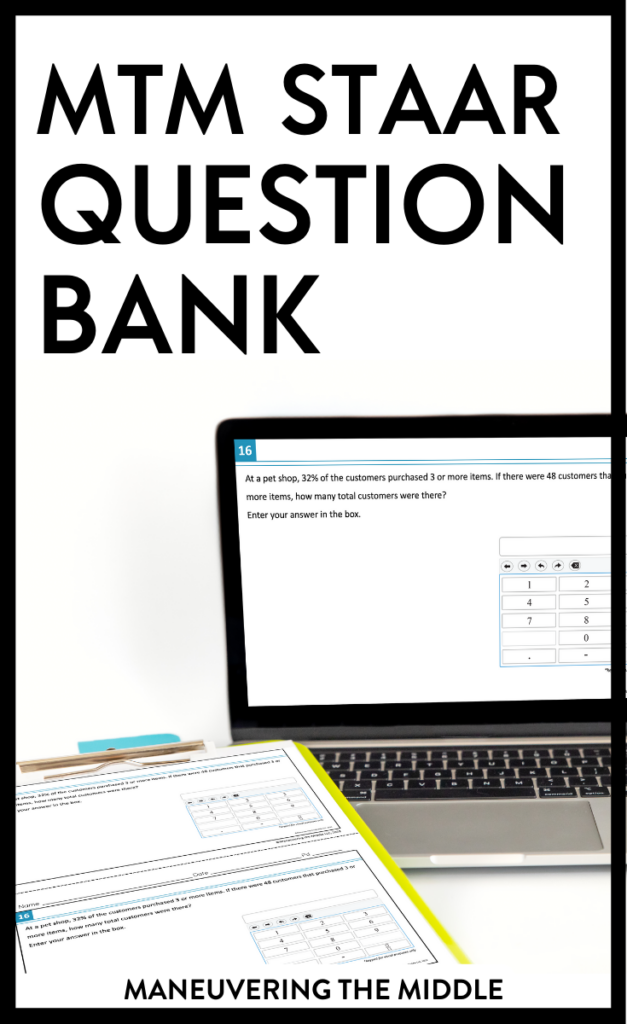STAAR is a registered trademark of the Texas Education Agency. Maneuvering the Middle® is not affiliated with or sponsored by the Texas Education Agency or the State of Texas.
For Texas Teachers
The STAAR (State of Texas Assessment of Academic Readiness) is moving online with a variety of new open-ended question types. Maneuvering the Middle has designed a bank of questions to prepare middle school math teachers for these changes.
This post is part 2 in our series about the STAAR redesign. To learn about all of the changes, go back and read last week’s post.
Today we are going to be chatting about our STAAR Question Bank and how you can use it in your math classroom.

Using the Question Bank
Every classroom is different – different students, different learning styles, and different class lengths. We sought to create a resource that can be flexible for teachers to use based on their students’ needs.
Recommendations:
- Gradually work through the questions together in class – Don’t assign students 20 STAAR new question types for homework. Testing can be stressful for students, and their confidence needs to be built not in isolation.
- Allow questions to encourage discussion and helpful clarification – Assigning the question bank as an independent assignment can result in missed opportunities for students to ask about the functionality of the online assessment.
- Select and use the questions your students need the most – The resource can still be effective even if your students don’t work on every single problem.

Classroom Routine Idea
I would recommend spending around 10 minutes on preparing students for the new question types by following this routine.
- Project a question and provide a paper copy to students (makes a great warm-up)
- Allow students a few minutes to work through the question on their own. Circulate and observe.
- Come back together to discuss solutions, strategies, and misconceptions. Provide feedback to students.
The STAAR Question Bank is intended to look exactly like what they will see on the STAAR test, but it doesn’t have the technology functionality. Fortunately, TEA has provided a STAAR online practice test (just click the green “Sign In” button at the bottom of the screen). Choose a day before STAAR to allow students to take a practice test where they can play with the functionality of the new question types and you can circulate and answer questions.
Strategies and Support for New Question Types
This is not exhaustive, but here is a list of things I would point out to students about the new question types.
- Equation Editor
- Allow students time in class to look at examples of keypads and ask any questions about unfamiliar keys.
- Ask questions such as – How would you handle a fraction? An equation or inequality? An exponent?
- When a question requires a fraction or exponent, pull up an equation editor sampler question to look at how certain functions appear.
- Graphing
- In most instances, students need to be able to identify correct points and not actually create the line aspect of the graph themselves; so in your practice, focus on discrete points and being able to test (x, y) values that are true for their scenario.
- After they have chosen points, ask – does the resulting line or shape make sense/seem reasonable? (Example: the slope should be negative but their points created a positive slope)
- Students will need to carefully observe the scales of the x and y-axis before creating the graphs.
- Number Line
- Highlight the differences in the button options (open, filled, left, right) as the buttons might all look similar and details can be easy to overlook.
- Remind students that there are two steps to creating a number line – selecting a button and then dragging the circle to the correct point on the number line.
- After the students create the number line, have them select a point in the solution set to check their answer.
- Inline Choice
- Encourage students to re-read their final selections as sometimes choosing an option mid sentence can interrupt their train of thought.
- Hot Spot
- Be sure they read to understand exactly what detail they are looking for (is it one point, two?).
- These are like multiple choice questions, but instead of A, B, C, D, they are choosing points on the graph.
- Remind students that they are often selecting more than one single point.
- Drag and Drop
- Read to see if options can be used more than once.
- Treat these like multiple choice questions and apply any same strategies – process of elimination or “plug in” choices to see if true
- Match Table Grid
- Take time first to read columns and understand what they are identifying, sorting, or classifying each statement by to provide guidance in how they read through each example
- Highlight that an answer must be selected in each row and not to leave a row unmarked
- Multiselect
- How many should I choose? Which are obviously incorrect?
STAAR Test Prep Unit + Question Bank
The STAAR Redesign Question Bank serves as a gradual practice where kids are becoming familiar with the question types over time. In addition, they are benefitting from spiral review over the readiness standards.
The test prep units, instead, provides a more intensive and immersive content review organized by unit concepts.
Teachers could combine the test prep unit together with the STAAR question bank. In both resources, there is more content than there are days to prepare, so teachers will need to prioritize what to focus on. But hey, that is what data is for!
What questions do you have about the STAAR Redesign Question Bank?






